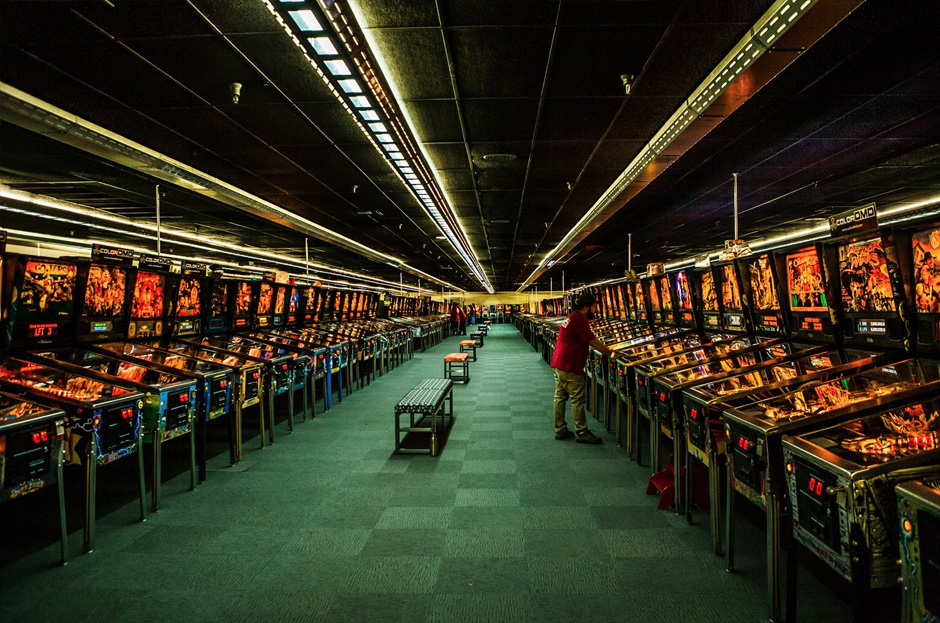Did you know pinball used to be illegal? Learn more about this and other interesting facts about the classic arcade game.

He’s a pinball wizard, there has to be a twist
A pinball wizard’s got such a supple wrist
How do you think he does it? I don’t know!
What makes him so good?
He ain’t got no distractions, can’t hear no buzzes and bells
Don’t see lights a-flashing, he plays by sense of smell
Always has a replay, never tilts at all
– The Who
Ready to get your game on? Retro Pinball Mania! takes place on February 15th at the Museum of Pinball in Banning and will feature craft cocktails and food alongside a chance to play your favorite machine. The museum, founded by John Weeks, who was bit by the pinball bug as a young kid, pays homage to a pastime that’s now finding a new generation of fans. Only open for a few weeks out of the year, the 40,000 square foot museum is home to over eight hundred machines and arcade games, from old school vintage tables to newer electronic models, attracting fans from as far away as Germany and New Zealand. In fact last year’s inaugural Arcade Expo made the Guinness Book of World Records when 331 people plunged and played pinball simultaneously.
Pinball is an offshoot of boules and bocce
Who would’ve thought that those lazy summer afternoon games played by the French was the precursor to those frenetic pinball matches that drank up the chilly afternoons of your college years? The evolution of the game from lawn bowling to indoor sport took place during the long reign of Louis XIV. When the games came inside for the winter, they graduated from floor-based sports to ones that could be played on a tabletop. Setting up the pins for a new game proved tedious however so impatient players quickly devised a new itineration. Fixing the pins in place and drilling holes, the pins morphed into targets against which to ricochet the balls into the holes.
Pinball used to be illegal
It’s hard to imagine but pinball was deemed illegal in 1942. Many people considered it a gateway pastime, a game of chance that appealed to children and would eventually tempt them into more serious forms of gambling. Though it may seem silly to us today, then-New York City Mayor Fiorello LaGuardia took the ban seriously and ordered a raid on the city’s pinball parlors, said to be run by the Mafia, seizing and smashing hundreds of machines and dumping them in the Hudson river. When The Who penned the lyrics to their song “Pinball Wizard” in 1972, it was still considered, alongside a leather biker jacket, a form of rebellion. Though the ban was overturned in New York City and across much of the country in the mid-70s, it is still illegal in a few places.
One play made pinball legal again
By 1976, pinball operators were frustrated and they lobbied to have the ban overturned. Their idea was to prove that, unlike gambling, pinball was not a game of chance, but one of skill and finesse. They brought in 26 year old magazine editor Roger Sharpe to prove their theory to the City Council. After a few tense minutes while Sharpe played on a machine he was unfamiliar with, he pointed to a spot on the table and predicted that, using only his skill, he’d hit it with his next ball. He pulled back the plunger and let the ball fly where it hit the exact spot he’d been pointing to only seconds earlier. The ban was overturned immediately.
The tilt used to be the defacto pinball move
Up until the invention of the flipper, players had to bump and tilt the machines to move the ball. Those pinball movers and shakers would not be allowed to play today. The flipper, invented in 1947, changed the game from one that relied on chance to one that demanded skill. It took practice to learn how to put the right spin on a ball to land it exactly where it needed to go. Electronic machines, introduced in the late 70s, included new distractions — those buzzers and bells of The Who song — and ramp systems that demanded increased concentration. Tilt mechanisms are now standard in all machines; activating the tilt sensor forfeits the game.
Pinball firsts and bests
The best selling pinball game of all time is The Addams Family, released in 1992. Designed by Pat Lawlor for Bally, it sold over 20,000 units. Another Lawlor-designed game for Bally, The Twilight Zone, released the following year, is a close runner-up. Wizard, based on the movie version of The Who’s rock opera Tommy — which featured the song “Pinball Wizard” — was the first licensed theme pinball machine. 1947’s Humpty Dumpty was the first pinball game to feature flippers although they faced outwards; Spot Bowler, released in 1950, was the first pinball game to feature the inward facing flippers we’re familiar with today.





